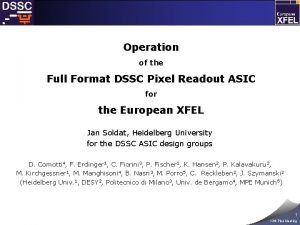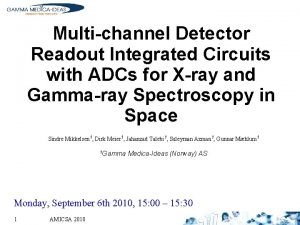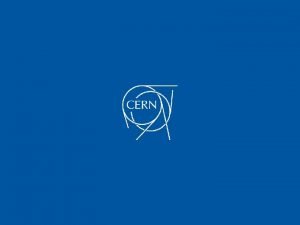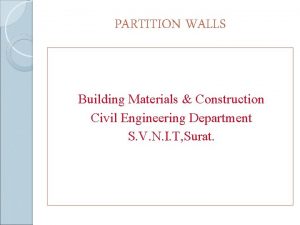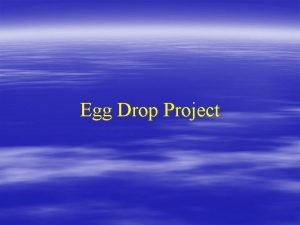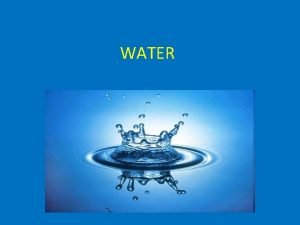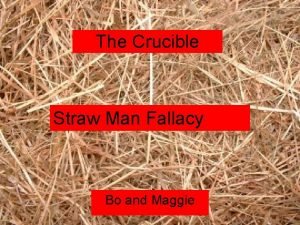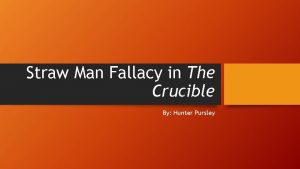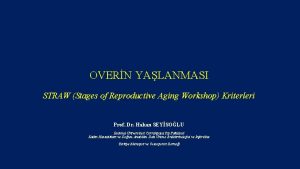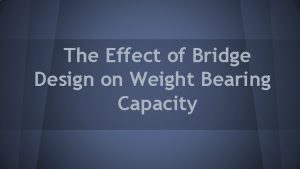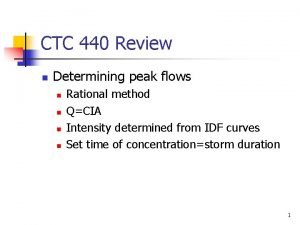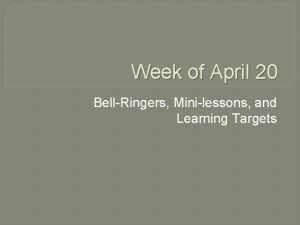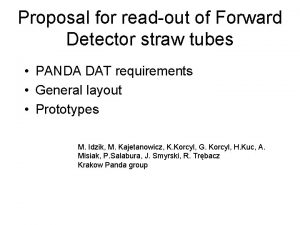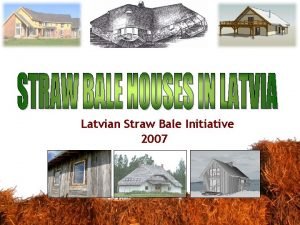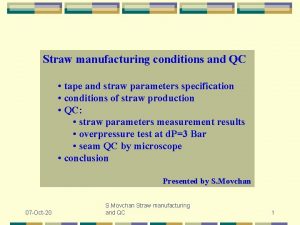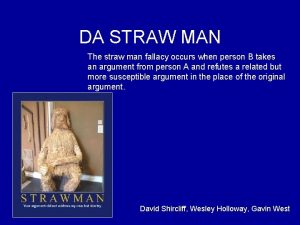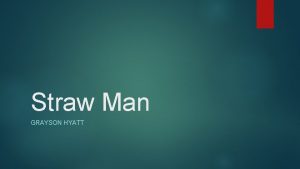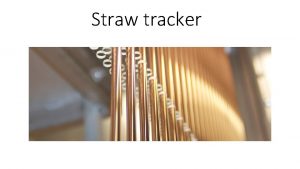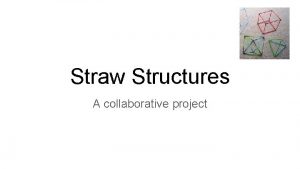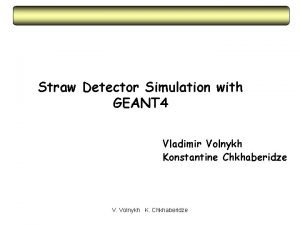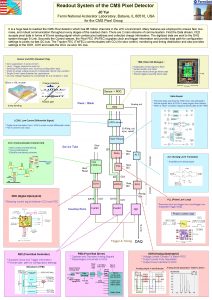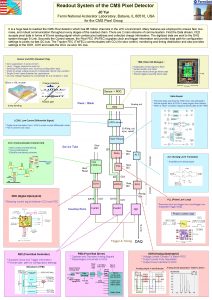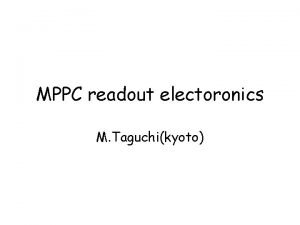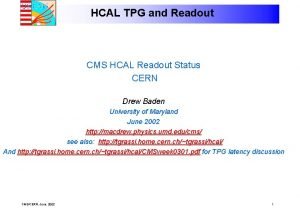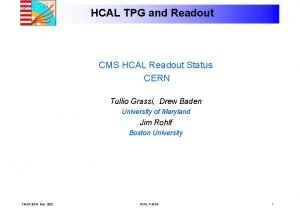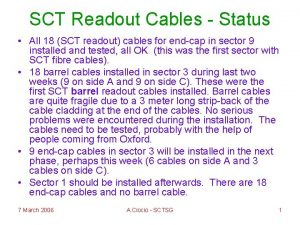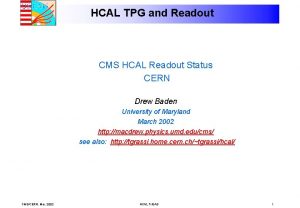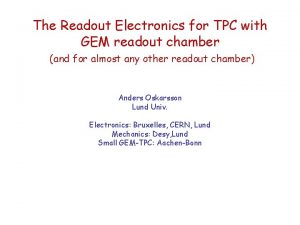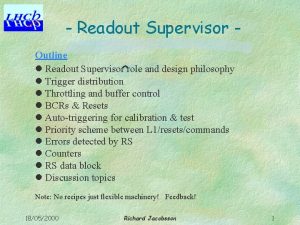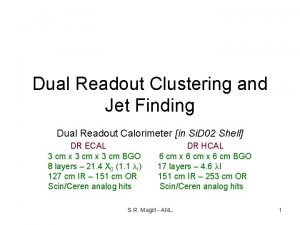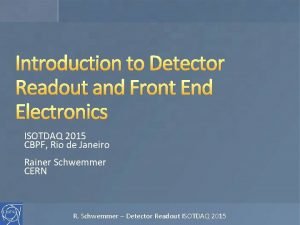NA 62 Straw detector readout system Introduction to























- Slides: 23

NA 62 Straw detector read-out system • Introduction to NA 62 • NA 62 layout • Straw detector • Requirements for straw detector electronics • Readout electronics • frontend • backend • Grounding and shielding • Triggering • Plans Peter LICHARD CERN (for NA 62) 1

NA 62 π+ K+ ν ν Measure the Rare Decay K+ -> (pion+) + neutrino + antineutrino ( BR of 10 -10) ~100 events in the lifetime of the experiment Extreme background (~1 GHz incoming rate, up to 10 MHz detectors) Principle Generate Kaons (needed total 1013 K+ ) Let them decay (~65 meters long tube) Observe product �signal acceptance �background suppression Peter LICHARD CERN (for NA 62) 2

NA 62 layout Peter LICHARD CERN (for NA 62) 3

Straw detector is Pion Spectrometer �Tracking �Momentum � 2 chambers before magnet � 2 chambers after magnet Recently �VETO function �Eventually can contribute to trigger Straw detector operates in vacuum (blue tube) Low mass , no influence on observed particles Peter LICHARD CERN (for NA 62) 4

Straw detector Straw construction Straw function Tube 2. 1 meter * 9. 8 mm 36 m thin PET foils PET = polyethylene terephthalate coated on the inside with 0. 05 m of Cu and 0. 02 m of Au The anode wire (Ø=30 m) is gold-plated tungsten Proportional (drift) chamber Measure particle distance from wire by drift time Operates in vacuum 1 bar working gas Straw electrical properties Propagation time full length ~7 ns Resistivity of anode 50 Ohm Resistivity of cathode 70 Ohm Metal few atomic layers, electrical properties determined by surface effects, no skin effect Straw is very lossy transmission line � 50 % of signal from far end Impedance frequency dependent � 1000 Ohms up to 1 MHz, 330 Ohm at 20 MHz Peter LICHARD CERN (for NA 62) 5

Straw detector Basic readout unit of 16 straws 4 layers of straws form a ‘view’ Data Control Services, DCS Grounding, shielding, ‘earth’ 4 views form a ’chamber’ 480 straws if all installed 30(15*2) groups of 16(8*2) straws Hole in the middle for beam View is a system readout unit Common electronics control, gas, LV, HV, signal return, etc 8 straws from 2 layers X, Y, U, V 4*480 = 1920 straws 4 chambers 2 before magnet, 2 after In total 1920*4 = 7680 straws (but hole for the beam) Peter LICHARD CERN (for NA 62) 6

Straw function • • • Falling edge has the same time for all straws on track. Rising edge gives the arrival time of the first cluster The closer is the track to the wall, the bigger is the signal (clusters closer) Don’t want to see clusters => shaping must be chosen in relation to gas properties Tracks from drift time measurement. Peter LICHARD CERN (for NA 62) 7

Peter LICHARD CERN (for NA 62) 8

NA 62 Straw tracker electronics Requirements on straw tracker from electronics point of view • • Good quality data (drift time) • 130 um resolution for single straw • Efficiency -> 100% • This is required • For all distances from the wire • All along the length of straw Low noise Low crosstalk efficiency and resolution versus rate • Ion tail cancellation Integration in global DAQ and TTC Reliable and stable operation with tools for monitoring Readout chain • • • ‘classical’ for time measurement Frontend • PA+SH+BLR+COMP • CARIOCA chip as a baseline (LHCb) • Other possibilities under study (including discrete electronics) Backend • TDC + storage and event management • Frontend control, online monitoring Peter LICHARD CERN (for NA 62) 9

NA 62 straw tracker electronics Required spatial resolution 130 um Needed TDC resolution ‘fast’ gas Ar/CO 2 (70: 30), muon test beam On X is bin (not resolution) Blue, unknown R-T dependence Red, known R-T dependence Peter LICHARD CERN (for NA 62) 10

NA 62 straw tracker Front. End electronics • Front end PCB Ø Gas tight PCB using blind vias (bottom faces working gas) Ø thick PCB to ensure mechanical stability Ø High voltage connection integrated on the board + HV filter Ø gas feedthrough Ø numerous configurable GND connections to try different grounding scheme with detector Peter LICHARD CERN (for NA 62) 11

NA 62 straw tracker Front. End electronics Front end board functionality Ø Ø Ø Two CARIOCA chips (16 straws) for signal processing 12 -bit DAC with I 2 C control for threshold setting LVDS buffers for outputs (to avoid current imbalances to feed-back to frontend) Even and odd test pulse buffers Power ~8 V/0. 12 A HV filter and connector • Front end connectivity Ø Ø Ø Data to DAQ on 16 differential (LVDS) lines for group of 16 straws Control from DAQ on 5 differential lines (I 2 C, TP) Power 8 V DCS – temperature sensors and power sensing lines changing connectors for HONDA VHDCI, 68 pins Peter LICHARD CERN (for NA 62) 12

NA 62 straw tracker Back. End electronics Backend readout requirements ‘triggerless’ system for straw, everything buffered till higher level trigger decision Data rate Measure arrival time of rising and falling edges � TDC resolution 1 -2 ns � Minimum width of pulse (<50 ns) � Time between pulses depends on straw rate Control � Threshold setting for each straw � Even/odd test pulses Event management and online monitoring Max rate per straw 0. 5 MHz Mean rate 33 k. Hz Need to store 32 bit clock ID from SPS START_OF_BURST + 8 bit ‘fine’ time + rising/falling edge + straw ID 9 bits 33 k. Hz * ~50 bits = 1. 65 Mbit/straw; 740 Mbits/view Desired functionality split to 2 boards Straw Readout Board (SRB) TELL 1 � � � TDC implemented in readout FPGA Receives precise clock and “Start Of Burst” signal from SPS Frontend control Online monitoring Sends data to TELL 1 over 1 optical fiber � � Developed for LHCB, adapted for NA 62 (TEL 62) Event building Event management Receives full NA 62 TTC control Peter LICHARD CERN (for NA 62) 13

NA 62 straw tracker data flow 1 chamber contains 2 modules 1 module contains 2 views 1 view is a smallest readout system 30 FE boards for 1 view 2 Straw Readout Boards 2 fibers (2 groups of 15 boards) TEL 62 Serving 2 chambers (2 x 4 views) STRAW READOUT & CONTROL Peter LICHARD CERN (for NA 62) 14

NA 62 straw tracker readout board (SRB) TDC Integrated in readout FPGA with bin 1. 6 ns TTC interface for precise clock and phase and reset signal for clock ID counter at SPS Start_Of_Burst Serving 14 FE boards 9 U VME board with control and monitoring through VME bus Data to TELL 1 sent via optical link Eventual trigger L 0 sent via optical link 2 needed per view 8 per station 32 needed for detector Scaled-down version in 6 U VME finishing design Plan to produce and used for tests before end of 2010 Peter LICHARD CERN (for NA 62) FPGA VME TTC FPGA TRIG+ DATA 15

External crosstalk, grounding and shielding Interference with external objects Voltage potential between front and back end Safety ground CONNECT Design Straw signal returns must be separated as much as possible All Sig. Ret connected at PCB level close to input of preamp The same point connected to metal case (vacuum tube) Straws connected to GND only on 1 side Metal case connected to experiment earth All shields (data, control, LV, HV) should be connected on both sides; 1 side directly, other through dumping impedance Backend (crate) connected to experiment earth. This provides the same potential for FE and BE – important for data transmission No direct connection between FE and BE ground apart EARTH => no GND loops PA PCB GND PLANE METAL CASE (VACUUM TUBE) SAFETY GND “EARTH” Peter LICHARD CERN (for NA 62) 16

NA 62 straw tracker electronics Used for lab tests and testbeam 2010 Waiting for analysis of testbeam data • Problems • CARIOCA too fast shaping even with fast gas • Signal overcompensated • Reacts to primaries • CO 2: iso => Ar: CO 2 • ~7 pulses => 1 -2 pulses • Spatial resolution compromised but still OK • Problems • Cables • heavy and rigid, not easy to handle • Always perpendicularly connected otherwise EMC compromised • Crosstalk Peter LICHARD CERN (for NA 62) 17

Slow gas analog and comparator outputs Peter LICHARD CERN (for NA 62) 18

Frontend status CARIOCA still baseline We consider also GASII � Characterization of the chip � Measurement with detector prototype discrete electronics � Design and layout done, functional 4 -channel demonstrator submitted to production Peter LICHARD CERN (for NA 62) 19

NA 62 straw tracker Front. End electronics (new ideas) Peter LICHARD CERN (for NA 62) 20

NA 62 straw tracker Front. End electronics with RJ 45 connector • Front end connectivity • ethernet connector (RJ 45) 4 differential lines • Data to DAQ on 1 differential (LVDS) line for group of 16 straws • Control from DAQ on 1 differential line • precise clock 40 MHz • 1 differential line spare (output for high rate straws? ) • Power 8 V and DCS on separate connector • Use standard halogen free ethernet cable • Design near finish • Production and test before end of year TDC and serializer CYCLONEIII FPGA in 256 pins FBGA package Peter LICHARD CERN (for NA 62) SMD RJ 45 Vertical connector 21

NA 62 straw tracker fast VETO/trigger Straw readout board Signal falling edge the same in a ‘view’ due to arrival of the last cluster and the same distance from the straw end 4 straw planes in a view Corridor example � Split view to ‘corridors’ � Size depends on trigger granularity � Require at least 2 straws with the same falling edge to validate track in the corridor � Window order ~1 ns � Send corridor number and time to trigger logic Trigger logic (custom board or TELL 1) Collects numbers from all 4 views Opens timing window > 7 ns due to propagation time in different views If there are hits from different views in the window, send corridor X, Y, Z and timestamp to straw central trigger Straw central trigger generates VETO on multiple charged tracks or trigger on 1 good pion track Peter LICHARD CERN (for NA 62) 22

Plans Finish characterization and testing of the frontend Decision on frontend in December/January In parallel, test TDC on and off FE-board with CARIOCA chip Decision on TDC in December/January Development and preproduction of final FE beginning 2011 Develop and produce small readout system Peter LICHARD CERN (for NA 62) 23
 What is the principle of spectrophotometry
What is the principle of spectrophotometry Full pixel readout
Full pixel readout Readout integrated circuit
Readout integrated circuit Readout units
Readout units The shepherd poem summary
The shepherd poem summary Magnitude of buoyant force
Magnitude of buoyant force Brick nogging partition
Brick nogging partition Logic in writing
Logic in writing Straw egg drop design
Straw egg drop design Hydrosphere facts
Hydrosphere facts Straw man fallacy in the crucible
Straw man fallacy in the crucible Strawman proposal
Strawman proposal Straw man in the crucible
Straw man in the crucible Straw kriterleri
Straw kriterleri How to build a straw bale dog house
How to build a straw bale dog house Once upon a time there were three little pigs
Once upon a time there were three little pigs Once upon a time there lived three little pigs
Once upon a time there lived three little pigs Best bridge design for weight
Best bridge design for weight Last straw
Last straw Anecdotal fallacy
Anecdotal fallacy Strawman argument
Strawman argument Straw in asl
Straw in asl Froude
Froude That old straw sojourner
That old straw sojourner

